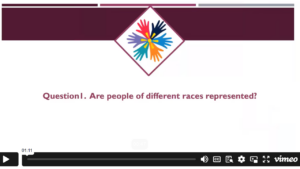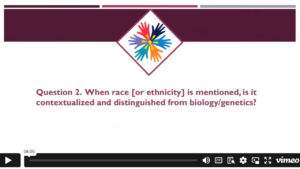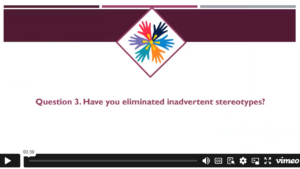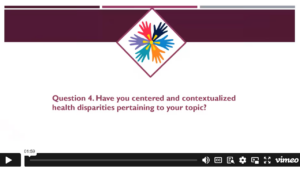Anti-Racism & DEI Course Materials Project
Learn How To Critically Appraise Course Materials for Instances of Bias

- Use the 5 questions below from Anti-Racism and Race Literacy: A Primer and Toolkit for Medical Educators (O’Brien et al., 2024) to critically appraise course materials for instances of bias.
- Click on the arrow to the right of each question to learn more about each question.
- We are highlighting resources created for educators because you will all be in positions to educate on health equity in the environments you work in after graduation – whether in the clinic, hospital, classroom, as a researcher or policy maker.
Take stock of representation in your case examples, images, questions, panel speakers, and invited lecturers. The choice of who is represented and how can reinforce associations that seed bias that impacts students’ clinical reasoning, breadth of history taking, and communication, which in turn harms future patients. Representation may signal educators’ priorities and values, which can impact the learning climate by influencing how learners view themselves and their communities, or by triggering stereotype threat. In addition to race, consider representation of other identities including gender, age, sexual orientation, ability, etc. (O’Brien et al., 2024, p. 25).
Watch the video below to view a demonstration of using this question. This is an excerpt from the Project History Video.
Race is a sociopolitical construct developed to stratify groups of people in order to privilege some (white people) at the expense of others (people of color). Biology-based definitions were mapped onto race to legitimize social subjugation and exploitation along constructed racial hierarchies. While both genetic predisposition and social forces like racism contribute to health outcomes, genetic predisposition to disease cannot be inferred from one’s race so racial disparities in health outcomes cannot be attributed to biology in the absence of discussion of genetic ancestry. Observed biologic differences that fall along socially constructed racial lines are more likely driven by sociopolitical inequities (e.g. access to health care, poverty, discriminatory law and policies, etc.) and racism. Thus, race is not a biological risk factor for disease, but rather a crude proxy for the risk conferred by exposure to racism. Contextualize race in the social history as a social determinant of health and use ancestry to capture genetic predisposition (O’Brien et al., 2024, p. 26).
Watch the video below to view a demonstration of using this question. This is an excerpt from the Project History Video.
Find them, fix them! Stereotypes function consciously or unconsciously as a heuristic [mental shortcut] that guides perception, interpretation, storage and retrieval of information, especially in conditions of high cognitive demand [such as in the healthcare setting]. Racialized stereotypes dehumanize and can dangerously narrow clinical reasoning by seeding bias, influencing our expectations, inferences, impressions, and limiting our ability to see others as unique individuals. Stereotypes are conveyed through the physical traits, names, abilities, linguistic patterns, roles, experiences, behaviors, code words, and illnesses you’ve associated with race. Your ability to detect these moments depends on your sensitivity to stereotypes and your blind spots, which we all have (O’Brien et al., 2024, p. 27).
Watch the video below to view a demonstration of using this question. This is an excerpt from the Project History Video.
Begin to disrupt racism by centering and prioritizing one of its consequences – health disparities. Scrutinizing racism as a driver of disparities helps prepare students to address the consequences of racism and fosters an equitable learning environment. Teaching content from the lens of those most impacted (those experiencing disparities) ensures that historically neglected voices are not overlooked while still allowing for discussion of pathophysiology, epidemiology, clinical presentation, treatment, etc. Avoid implying that individual behaviors are to blame for disparities. Instead zoom out and contextualize disparities in the structural forces driving them in order to identify root causes and opportunities for intervention, broaden clinical reasoning, and uncouple race from false notions of pathology due to innate racial differences (O’Brien et al., 2024, p. 28).
Watch the video below to view a demonstration of using this question. This is an excerpt from the Project History Video.
“Reflect on who benefits from or is burdened by the content, message, and perspectives represented in your materials. Consider the immediate and downstream impact on learners, patients (present and future), families, communities, staff, and colleagues” (O’Brien et al., 2024, p. 29).
Watch the video below to view a demonstration of using this question. This is an excerpt from the Project History Video.
O’Brien, M., Fields, R., & Jackson, A. (2024). Anti-racism and race literacy: A primer and toolkit for medical educators. UCSF School of Medicine. https://medschool.ucsf.edu/differences-matter/action-groups/focus-area-3
Learn More About This Project:
- Project Overview & Bias Submission
- Project Stats
- How This Project is Creating Meaningful Change
- Project Founders & Contributors
- Contact Us




